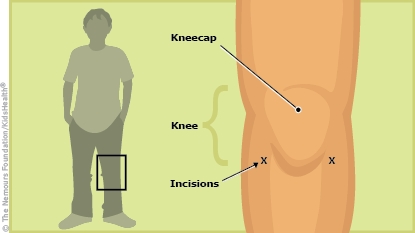After Knee Arthroscopy: How to Care for Your Child
Following the surgeon's post-operative instructions can help your child recover more quickly and return to normal activities sooner.


Arthroscopy is a type of surgery that can be used to diagnose or repair knee injuries. The surgeon makes a small opening near the knee and puts in an arthroscope — a thin tube that has a tiny camera attached to it — to see inside the knee.
The surgeon then makes other small incisions (cuts) to fit tools through to do the surgery. Arthroscopy is called "minimally invasive" surgery because the incisions are small.

-
Give your child any medications as prescribed by the health care provider.
-
Follow the health care provider's instructions about the removal of surgical dressings.
-
If your child has swelling, numbness, coldness, or tingling in the foot, loosen the bandage (not the dressings) and raise your child's leg on a pillow so that it is above heart level.
-
Your child should do post-operative movement exercises as instructed by the health care provider.
-
Apply a plastic bag filled with ice or a cold pack to the injured knee as often as the health care provider instructs. Keep the bandage or a towel or cloth between the ice/cold pack and the skin to prevent frostbite.
-
Your child should not take a bath, but can start showering on the third day after surgery. Wrap the knee in a plastic bag that is taped shut to keep the leg dry.

-
Your child may stop using crutches as soon as it's comfortable to do so. This usually takes 3–5 days.
-
Teens who drive may do so once they're comfortable enough to use the pedals and are no longer taking narcotic pain medication. Braces should be unlocked or removed before driving.

Your child:
-
Is unable to urinate (pee) the evening of the surgery.
-
Has swelling or numbness that is not relieved by loosening the bandage and raising the leg.
-
Has a lot of fluid or blood draining from the surgical site.
-
Has a temperature above 101°F on two readings 2–3 hours apart more than 48 hours after surgery.
-
Has severe pain after 48 hours.

Your child: